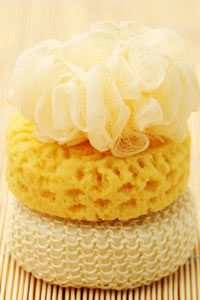After a long day or a grueling workout, a hot bath might be your top priority. But before you start scrubbing, take a look at your bath sponge, and ask yourself how long it's been since you replaced it. If you can't remember, it's probably been too long. You might think you're just being frugal, but hanging on to a well-used bath sponge may mean that you've created a new home for bacteria and mold -- a home that touches your body on a daily basis.
Whether it's a synthetic mesh bath pouf, a loofah or something else, regularly changing out your used bath sponge for a new one can keep bacteria and mold at bay. In the warm, wet atmosphere that exists in most bathrooms, these organisms can grow quickly, and they could spread to your skin if you don't change your sponge regularly. This misuse of sponges can lead to rashes or infections due to bacteria, and using a sponge that hasn't been properly cleaned or stored can also promote the growth of mold in your home.
Advertisement
After using your sponge each day, you should wring it out to remove excess water and hang it in a well-ventilated area to dry. Remember that synthetic, or human-made, materials will dry faster than natural ones, like loofahs or sea sponges. Dermatologists recommend that you throw out a loofah after three to four weeks, since it easily grows bacteria in its crevices, and by that time will have lost some of its exfoliating properties. You should toss a mesh bath pouf, which is more resistant to bacteria, after eight weeks [sources: Crean, Fitness Magazine]. If you want to be extra cautious, you can also disinfect your bath sponge every few days.
The presence of bacteria is a fact of life, and it exists everywhere. Read on to learn how to minimize the risks to your health caused by the bacteria on your bath sponge.
Advertisement

